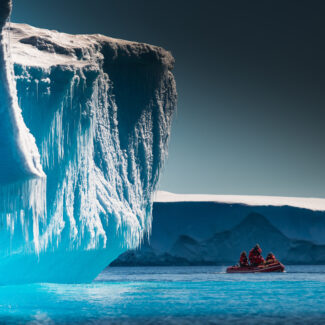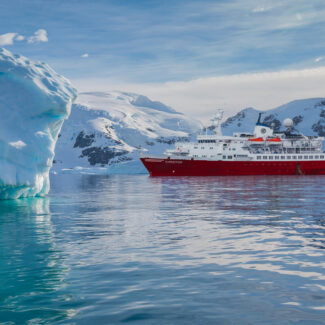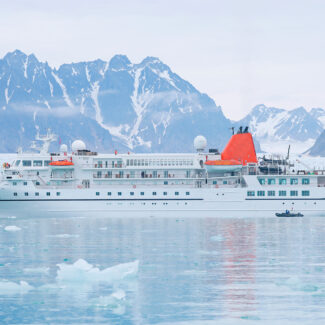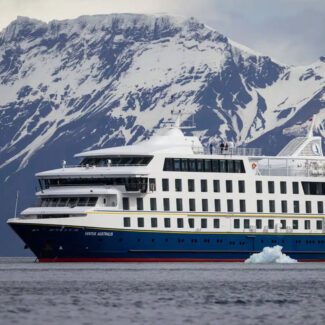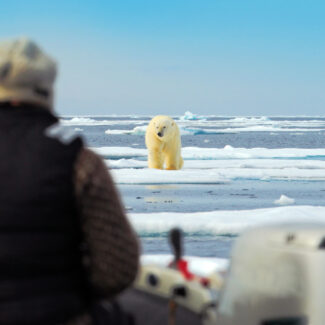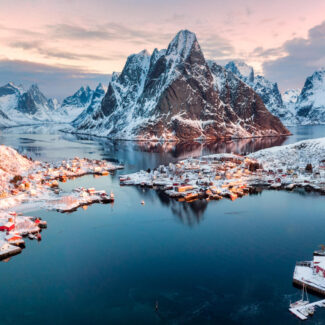Top 10 Historical Places, Heritage Sites & Monuments In Antarctica To Visit
- 1. Grytviken (South Georgia), Including the Ernest Shackleton Grave Site
- 2. Monument to the Antarctic Treaty & Plaque (King George Island)
- 3. The Ceremonial South Pole (Amundsen-Scott South Pole Station)
- 4. Von Tunzelmann Point (Cape Adare)
- 5. Observation Hill Cross (Ross Island)
- 6. Casa Omond (South Orkney Islands)
- 7. Port Lockroy (Palmer Archipelago)
- 8. Lenin’s Bust at the Point of Inaccessibility Research Station
- 9. Whalers Bay, Deception Island
- 10. Antarctica’s Historical Expedition Huts
- Antarctic Heritage Sites & Preservation
Antarctica may not boast millennia of human occupation or indigenous culture like some parts of the world, but it certainly boasts some heraldic and fascinating history.
While dazzling and primal natural scenery and wildlife usually take center stage on sightseeing cruises and other Antarctic tourism experiences, the White Continent’s historical sites and monuments are profound destinations that can, for those lucky enough to visit, serve as something like virtual time machines, summoning the full sweep of this icy wilderness’s human story.
Here are some of the top historical places in Antarctica, presented in no particular order!
1. Grytviken (South Georgia), Including the Ernest Shackleton Grave Site
Established as a Norwegian whaling settlement in 1904—and helping usher in the era of commercial Antarctic whaling—Grytviken is no longer permanently inhabited, but remains a popular stop on many Antarctic itineraries.
It contains a number of exceptional historical sites, including the 1913-built Whaler’s Church and its associated Grytviken Cemetery, which contains more than 60 graves, the oldest dating back to 1838. None are so famous as that of the great Antarctic explorer Ernest Shackleton, who died of a heart attack on South Georgia in January 1922 while preparing to accompany yet another venture, the Shackleton-Rowett Expedition, to Antarctica. His tombstone comes marked with a nine-pointed star, a family symbol. The Shackleton burial site remains the most sought-out historical draw on the island.
A 10-minute stroll away from the cemetery stands the South Georgia Museum, well worth a visit as well for its fine exhibits on whaling and other historical subjects.
At Grytviken, South Georgia, the tranquil Whalers’ Church stands as a poignant reminder of a bygone era and the island’s rich, often harsh, history as a whaling hub, a truly significant Antarctic heritage site.
2. Monument to the Antarctic Treaty & Plaque (King George Island)
Situated on the Fildes Peninsula of King George Island—biggest of the South Shetland Islands and a classic springboard for visits to Antarctica—this conical, globe-topped monument was unveiled in 1999 on the 40th anniversary of the signing of the Antarctic Treaty, which helps guide international management and cooperation on the world’s most remote and little-trammeled continent.
The monument, which includes a quartet of plaques commemorating the signing of the Treaty in its four official languages (Spanish, English, Russian, and French) lies near three notable Antarctic research stations: two of Chile’s, Base Presidente Eduardo Frei Montalva and Profesor Julio Escudero Base, and one of Russia’s, Bellingshausen Station.
3. The Ceremonial South Pole (Amundsen-Scott South Pole Station)
The Geographic South Pole—the southernmost point on Planet Earth—was the preeminent goal of the Heroic Era of Antarctic Exploration, and it was finally attained in December of 1911 by the Norwegian explorer Roald Amundsen and his party.
Immense hardships were required of such early adventurers to reach this sublimely out-of-the-way point, but today fly-in tourists enjoy the Ceremonial South Pole as one of the world’s great photo ops, right alongside the Amundsen-Scott South Pole Station marking the actual South Pole.
The Ceremonial South Pole flutters with the flags of all the nations that were the original signatories to the Antarctic Treaty: the United Kingdom, the United States, Russia, Argentina, Chile, South Africa, Belgium, Australia, France, New Zealand, and Japan.
Reaching the Ceremonial South Pole at Amundsen-Scott Station represents the ultimate triumph of exploration, honoring the spirit of discovery that continues to drive scientific endeavors in Antarctica’s extreme frontier.
4. Von Tunzelmann Point (Cape Adare)
It’s not at all 100% clear who first set foot on mainland Antarctica, but a lot of signs point toward the New Zealander Alexander Von Tunzelmann, among the party of the Norwegian whaling/sealing ship Antarctic that came ashore here near Cape Adare on January 24th, 1895.
Given the landing boat contained a number of crew members who slogged through the surf onto Ridley Beach within moments of one another—and given the bragging rights understandably available for the individual executing that first-ever footfall on the White Continent—the confusion is understandable. (Learn more about the earliest discovery of Antarctica here.)
But the fact that this icy shoreline ended up named (through the efforts of the New Zealand Antarctic Place Names Committee) for Von Tunzelmann, despite competing claims among that landing boat’s crew—and despite the possibility that an American sealer, John Davis, may (may!) have landed on the Antarctic mainland some years before—doesn’t diminish its significance as a historical landmark.
5. Observation Hill Cross (Ross Island)
This nine-foot-tall wooden cross commemorates one of the defining tragedies of Antarctic exploration: the deaths of Robert Falcon Scott and his four companions on their return journey from the South Pole, which they reached—a bit more than a month after Amundsen’s Norwegian party—in January 1912.
Members of Scott’s British Antarctic Expedition who’d served as the search party after Ross and his companions erected this cross in January 1913. It stands atop Observatory Hill, a 754-foot-tall lava dome, close to the U.S. McMurdo Station, the largest research base in Antarctica.
Perched high on Observation Hill, this poignant cross serves as a timeless memorial to Captain Scott and his valiant Terra Nova expedition team, embodying the enduring spirit of Antarctic exploration.
6. Casa Omond (South Orkney Islands)
The first meteorological station established in Antarctica was the stone hut called Omond House, built in 1903 from available rocky materials on Laurie Island in the South Orkneys by the Scottish National Antarctic Expedition.
Transferred the following year to Argentina, this station anchored the resulting Orcadas Base, which ranks as the longest continuously operating year-round research base in the Antarctic. Omond House, known on the grounds as Casa Omond, still stands: a remarkable holdover from the earliest days of scientific inquiry in this absolutely singular polar laboratory.
7. Port Lockroy (Palmer Archipelago)
This abandoned British research station, situated on a harbor of Wiencke Island in the Palmer Archipelago off the Antarctica Peninsula’s west coast, dates back to some of the formative days of Antarctic exploration. Port Lockroy was the first of three permanent Antarctic bases established during Britain’s under-wraps Operation Tabarin in 1944, and became the foundational locus of the venerable British Antarctic Survey.
Port Lockroy closed in January 1962, but since the mid-1990s has been managed by the U.K. Antarctic Heritage Trust as a historic site and interpretive center.
These days, some 18,000 visitors take in Port Lockroy’s dramatic ice-clad mountain backdrop and its museum—housed in the largest of its three buildings, Bransfield House—each austral-summer season.
Step back in time at Port Lockroy! This preserved British base offers a unique glimpse into Antarctic history, now a museum and post office, making it a truly captivating heritage site.
8. Lenin’s Bust at the Point of Inaccessibility Research Station
A terrifically lonesome bust of Vladimir Lenin protrudes from the wind-whipped snowpack at the long-abandoned research station Point of Inaccessibility, so-named on account it was thus situated—that is, at the location on the White Continent farthest from a seacoast—when the Soviet Union established it in 1958. The plastic statue of Lenin, mounted on the station roof via a wooden base, faces toward Moscow.
The Point of Inaccessibility station was evacuated soon after construction, deemed too remote for regular usage. Nowadays, the station lies almost wholly buried under this ferociously cold spot’s snows, with the Lenin bust the most significant visual marker left.
Needless to say, this isn’t really much on the typical Antarctic tourist beat, but we contend the sheer oddity of that familiar visage presiding over one of the most remote locales on the planet warrants inclusion in this here roundup of Antarctica monuments—and serves, indeed, as a suitably quirky, suitably back-of-beyond site to close it out!
9. Whalers Bay, Deception Island
A place of eerie beauty and ghostly remnants, Whalers Bay on Deception Island—the caldera of an active volcano—offers one of the most haunting glimpses into Antarctica’s human history. This sheltered cove, with its black volcanic sands steaming from geothermal heat, was once the heart of the Norwegian Aktieselskabet Hektor whaling station, where blubber was boiled down in massive rusting digesters still strewn across the shore.
From 1912 to 1931, whalers worked here, reducing the world’s largest creatures into oil—until overhunting made the industry unsustainable. Later, during World War II, it became a base for British scientific and mapping activity, until 1969 when a violent volcanic eruption forced a hasty evacuation. The remains of Biscoe House (a dormitory for the whaling station), an aircraft hangar, and a graveyard buried by mudflows still stand as frozen witnesses to the historic human exploits within the bay.
Today, the abandoned station is a time capsule, where decaying buildings and whalebones contrast against the many chinstrap penguins now reclaiming the bay. A site of history, devastation, and rebirth, Whalers Bay is a must-visit for those seeking the storied past of the White Continent.
Explore the haunting beauty of Whalers Bay on Deception Island, where remnants of a bygone era stand against a dramatic volcanic landscape, a powerful testament to Antarctica’s rich, yet challenging, human history.
10. Antarctica’s Historical Expedition Huts
Antarctica’s cold, dry climate means that historical structures often stand the test of time to a remarkably well-preserved degree, especially when given some tender loving care by devoted organizations such as heritage trusts. Such is the case with a number of early 20th-century huts built by iconic Antarctic expeditions and now popular tourism destinations.
These include Discovery Hut, erected at Hut Point on Ross Island in 1902 by Robert Falcon Scott’s British Antarctic Expedition and just a stone’s throw from McMurdo Station. Then there’s Shackleton’s Hut, built at Cape Royds during the Nimrod Expedition of 1907-1909 and occupied by Ernest Shackleton and his men for some 14 months.
Over on the north coast of Cape Evans, meanwhile, Scott’s Hut is a poignant relic from Scott’s Terra Nova Expedition of 1910-1913, during which he and four other men perished while trekking back from the South Pole.
Other, slightly less-well-known early expedition bases include Borchgrevink’s Hut at Cape Adare (dating from the British Antarctic/Southern Cross Expedition of 1898-1900) and the much later Hillary’s Hut (1956-’57) at Scott Base.
We’ve got a whole separate article on some of Antarctica’s famous expedition huts, by the way, if you want to learn about them at greater depth!
Ernest Shackleton’s historic hut stands as a testament to the extraordinary courage and resilience of early Antarctic explorers, offering a tangible link to their remarkable scientific and survival achievements.
Antarctic Heritage Sites & Preservation
Most of the above sites are among the nearly 100 that are officially designated Historic Sites or Monuments (HSMs) of Antarctica, defined through the Antarctic Treaty System as a specific class of Antarctic Protected Area.
Among the charities and non-profits that help preserve and advocate for particular historic sites in Antarctica are the U.K. Antarctic Heritage Trust, which cares for six sites on the Antarctic Peninsula, and the New Zealand-based Antarctic Heritage Trust, assisting in the preservation of a number of historical expedition huts on the White Continent.
Disclaimer
Our travel guides are for informational purposes only. While we aim to provide accurate and up-to-date information, Antarctica Cruises makes no representations as to the accuracy or completeness of any information in our guides or found by following any link on this site.
Antarctica Cruises cannot and will not accept responsibility for any omissions or inaccuracies, or for any consequences arising therefrom, including any losses, injuries, or damages resulting from the display or use of this information.


